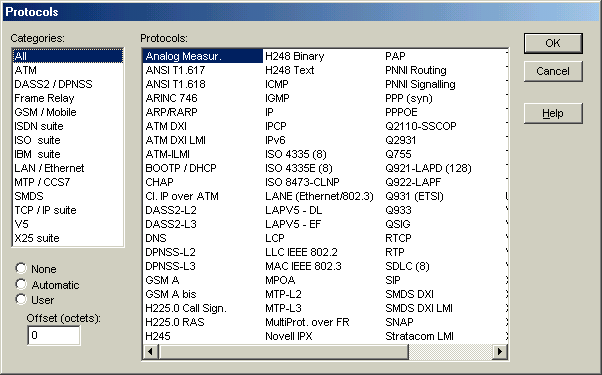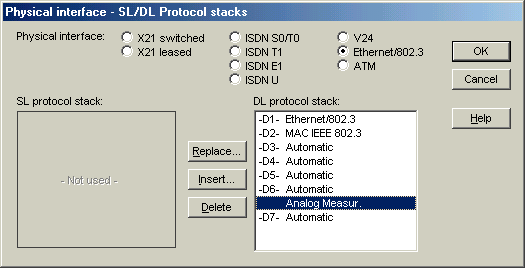|
|
|
Clarinet Analog measurement: monitoring functions
The Clarinet Run-time package includes a tool allowing to measure the
Quality of the voice carried over Trunk bearers or over IP networks.
The Clarinet QoS is a Clarinet function designed for the
company’s Clarinet platform. Clarinet
Run-time package includes new capabilities to process the voice flow:
- in monitoring mode to translate the voice flow resulting from
clarinet acquisition into wav files
- in simulation mode to generate wav file and provide QoS
ratios.
"Analog measurement", defines a new
type of events coming from Byte-TS flow over TS of ISDN Bchannels, SS7
links, E1/T1 Trunks, Clarinet processing translates the events into wav files.
 |
|
|
"Analog measurement", a
new type of data can be selected from the protocol stack of the
filter to decode the Voice Quality of Service events. |
|
 |
|
|
The Clarinet acquisition specified in the
profile as Byte-TS generates Byte-TS events resulting from monitoring of the
samples in the Voice channels over E1, T1 or BRI interfaces. |
|
 |
|
|
When the "Analog measurement"
is specified above Byte-TS, an additional TAB appears in the
filter in order to specify the voice parameters and the type of
measurement. |
|
 |
The "Received Voiced" specifies the parameters and the
output file for the monitoring:
- Encoding specifications of the samples in Byte-TS(G711 m-Law,
A-Law...)
- Jitter buffer size
- Name of the wav files: two wav files are automatically
generated (T and R directions)
- Encoding specifications of the wav files
The "Quality Measurement" specifies the type and the
options of the measurement: |
|
|
|
|
The Clarinet processing of Byte-TS events
generates wav files (name specified in the filter panel) and QoS events resulting from
Byte-TS events.
|
|
 |
|
|
|
|
| "Analog measurement", a
new type of data can be selected from the protocol stack of the
filter to decode the Voice Quality of Service events. |
|
 |
|
|
When the "Analog measurement"
is specified above Byte-TS, an additional TAB appears in the
filter in order to specify the voice parameters and the type of
measurement. |
|
 |
The "Received Voiced" specifies the parameters and the
output file for the monitoring:
- Encoding specifications of the samples in RTP flow
- Jitter buffer size
- Name of the wav files: two wav files are automatically
generated (T and R directions)
- Encoding specifications of the wav files
The "Quality Measurement" specifies the type and the
options of the measurement:
- PSQM or PESQ
- The wav file used as a reference
The following Codecs are supported:
- ITU G711 m-Law 8 kHz, 8 bits
- ITU G711 A-Law 8 kHz, 8 bits
- ITU G711 Linear 8 kHz, 16 bits
- ITU G726-40 ADPCM 8 kHz, 5 bits
- ITU G726-32 ADPCM 8 kHz, 4 bits
- ITU G726-24 ADPCM 8 kHz, 3 bits
- ITU G726-16 ADPCM 8 kHz, 2 bits
|
|
|
|
|
|
The Clarinet acquisition uses the stack of
protocol specified in the filter to generate RTP events resulting from monitoring of
IP / UDP packets over LAN or WAN interfaces.
|
|
 |
|
|
|
|
The Clarinet processing of RTP events
generates wav files (name specified in the filter panel) and QoS events resulting from
Byte-TS events.
|
|
 |
|
|
Average results are generated at a
time defined by the value of "Delay between meas." in the
filter.
|
|
 |
|
The Clarinet "analog measurement" events
refer to the IP flow identification by including the IP addresses
and the UDP port addresses in the header.
|
